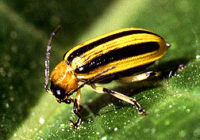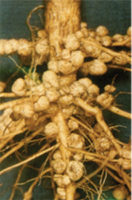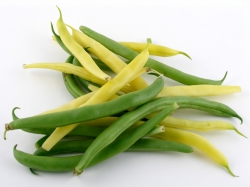Beans
There are 3 classifications for beans: Green or Snap Bean, both pole and bush; Shelling bean, both pole and bush; and Dried beans, both pole and bush. All of the three types have about the same growing requirements, although there are differences in harvesting.
The five most common problems gardeners have with beans are:
- Poor germination
- Improper spacing
- Unexpected hot spells
- Insects
- Diseases
Germination problems are generally from planting too early in cold soil. Soil should be in the 60 degree range before planting. Lima beans, especially, need warm soil temperatures above 65 degrees for good germination. Plant with the eye of the bean pointing downward. If planting early, warm up the soil by covering the planting area with row covers for a few days. Try soaking or pre-sprouting seed and keep under row covers until plants have their second set of leaves. Be sure to water the rows or bed well before planting, then don't water again until seedlings are up.
There are two ways to speed up seed sprouting. Seeds can be soaked in tepid water overnight and planted in the garden the next day. Seeds can also be pre-sprouted before planting. To do this soak seed in water over night, then drain and spread the seed on a damp paper towel. Fold the towel over the seed and place it in a plastic bag. Keep the bag in a warm location such as the top of the refrigerator. Check the seed daily and plant in the garden as soon as sprouts begin to appear. The planting bed should be ready to seed and the soil should be moist. Handle sprouted seeds carefully to avoid damage. Plant sprouted seed one-inch deep with the sprout (root) facing down. Cover seed with damp soil and water in, then, do not water again until seedlings emerge.
Spacing is very important on early bush beans in areas of high humidity. Rows should be at least 18 inches apart because plants will fill in between the rows. If planted too close, only the outside rows will yield well. Space seed 3 - 4 inches apart and thin seedlings 6 - 8 inches. On a wide row or bed, spacing of 6 - 8 inches in all directions has disadvantages. Plants will shade the ground but having to handle wet plants to pick beans spreads foliage diseases. Don't plant beans in low damp spots. Plants need good air circulation and drying sun in the morning.
Hot spells can occur in some inland areas even as early as May. There are several varieties that won't set flowers and produce beans when the temperatures are in the 90's. High temperatures interfere with pollen formation. One variety that is especially susceptible to the problem is the scarlet runner bean. If a catalog description says the bean does well in the North or in cool weather, don't buy it for Southern California inland areas.

Insects that are the most destructive to bean plants are the cucumber beetle, leafhoppers and the aphid. They do chewing (cucumber beetle) and sucking damage (leaf hoppers and aphids) as well as transmit viral diseases. Late-planted beans are bothered by red spider mites that can defoliate the lower half of the plants. An untreated infestation will at times completely defoliate the plants. Leafminers are also a late season pest on pole beans and black aphid can attack cowpeas and asparagus beans in mid-summer.
Diseases can damage beans. Rust, a fungal disease, can be a problem in shady damp spots or plants shaded by taller plants in the early summer. Keep leaf litter picked up under plants and use dusting sulfur at first sign of reddish pustules on the back of leaves. Don't use sulfur when temperatures go into the 80's - it can burn leaves.
Dispose of all crop residues as rust can have an over-wintering spore that will germinate next spring. Bean Mosaic disease causes distorted leaves and beans. There are resistant varieties for this disease. Rotation of bean crops around the garden is necessary if you have a problem with damping-off disease or seed rot. Rotate with non-legume crops. This way the disease can't build up in the soil. Don't plant peas after beans or beans after peas as they can both be infected by the same diseases.
FERTILIZATION
Beans are legumes and fix nitrogen from the aid of the rhizobium bacteria that live in the nodules on the bean roots. In a new garden, where beans have never been grown before, there probably isn't specific rhizobium for the beans or peas you want to grow. If you are growing beans or peas as a food crop they do need additional feeding of nitrogen for maximum yield, especially long season pole beans and dry bush beans. Use a complete vegetable fertilizer as a pre-plant (5-10-5) at the rate of one pound per 100 square feet, tilled into the top 6 - 8 inches of soil. If you replant as soon as a crop comes out, add fertilizer to help decompose old roots. On long season beans, side dress with 5-10-5 after the first big picking. If you are growing organically, use a good mix, or combination of organic fertilizers.
WATERING is critical during flowering, pollen formation and pod enlargement.
If you plan on growing a legume for soil improvement (green manure), such as fava beans, they should be inoculated with the proper rhizobium bacteria. The prime reason for planting legumes, (peas, beans, vetches, clover, alfalfa) is their importance in fixing nitrogen into the soil in forms that other plants can use. This greatly reduces the need for supplemental nitrogen fertilization. To get the maximum vegetative growth, the legume needs to be inoculated with its specific rhizobium (rhizobia is plural). There are thousands of strains of rhizobia bacteria which will work only on the seeds they have been selected for. Example: The rhizobium that will effectively nodulate soybeans will not cause nodules to form on alfalfa. These bacteria are alive and have a definite shelf life; they can be killed by improper handling and storage.
By inoculating the seed, the bacteria is introduced into the soil in quantities large enough to produce early formation of nodules and an adequate supply of nitrogen for plant growth during the critical growth stage. The addition of this plant organic matter to poor soil enriches it with nitrogen and improves fertility and tilth of the soil.
 Rhizobia bacteria and legume seed source:
Rhizobia bacteria and legume seed source:
Peaceful Valley Farm Supply
P.O. Box 2209
Grass Valley CA 95945
530.272.4769
http://www.groworganic.com
Planting Dates
Coastal:
Transplanting Dates:
April - June
Inland:
Transplanting Dates:
April - June
Varieties
BEAN VARIETIES (CATALOG SOURCES 2010)
| Variety | Maturity | Type | Resistance | Source*** |
| Topcrop | 51 days | Bush | Mosaic | VBS, ST |
| Tendercrop | 55 days | Bush | Pod Mottle | NI, VBS, ST |
| Contender | 49 days | Bush | Mildew | VBS |
| Derby | 57 days | Bush | Mosaic | NI, VBS, ST |
| Marbel | 54 days | Bush | Anthracnose | VBS, ST |
| Oregon Blue Lake | 54 days | Bush | NI | |
| Royal Burgundy | 53 days | Bush | NI, VBS, ST | |
| Romano | 63 days | Bush | NI, ST | |
| Roc d'Or | 43 days | Bush | Anthracnose | NI, RG |
| Purple Podded | 65 days | Pole | Coast | VBS |
| Romano | 70 days | Pole | Inland | NI |
| Oregon Blue Lake | 60 days | Pole | Coast | NI |
| Kentucky Wonder | 58 days | Pole | Inland | ST |
| Kentucky Blue | 57 days | Pole | Both | VBS |
| McCaslan 42 | 62 days | Pole | Inland | BC |
| Yard Long or Asparagus Bean | 80 days | Pole | Inland | NI, VBS |
| Christmas Lima* | 85 days | Pole | VI | |
| Thorogreen Baby* | 68 days | Bush | NI | |
| Fordhook 242* | 70 days | Bush | ST | |
| King of the Garden* | 85 days | Pole | ST | |
| French Hort.Beans** | 68 days | Cross bush/pole, Pods red and yellow streaked | ST, VBS |
*Lima Beans:All take heat
**Horticultural Beans: Can be used as a green bean, shelled for mature beans or dried
***SOURCES:
Baker Creek Heirloom Seeds, BC: http://rareseeds.com
Nichols Seeds, NI: www.nicholsgardennursery.com
Stokes Seeds, ST: www.stokesseeds.com
Vermont Bean Seeds, VBS: www.vermontbean.com
Victory Seeds, VI: www.victoryseeds.com
Most beans for shelling or drying take 85 - 100 days to harvest. Pick a variety for your climate. Some do better inland, others along the coastal zone. Vermont Bean Seed Company has the largest selection.
If you save your seed for replanting, dry thoroughly, then place the seeds in a freezer bag and freeze to kill weevil eggs. When you are ready to plant, thaw in the refrigerator and plant within 1 - 2 days.
Some varieties are not necessarily the best for our area every year, but they are good producers under cool growing conditions: Topcrop, Tendercrop, Burgundy Purple Pod, Earlywax (all bush varieties), & Romano, bush or pole, Kentucky Wonder, bush or pole.
 SHELLING VARIETIES:
SHELLING VARIETIES:
Christmas Lima, pole; Dr. Martin, pole lima; Kentucky Wonder, pole; Wren's egg, pole; King of the Garden, pole lima; Cow pea (also called Field Pea, Black Eyed pea, Crowders, (or Southern) is placed here because it is a warm season pea. A high yield variety developed by the University of California is California Black-eyed pea. Other high yield varieties are Soy bean, Envy Butterbean, Green Giant and Yellow Soybean.
DRY BEANS:
Jacob's Cattle Bean, bush, Great Northern White Bean, Pinto bean, wy#166, Navy bean, Seafarer, French Horticultural, Garbanzo, McCaslan and Light Red Kidney bean. There are many others in heirloom seed catalogs.
Also check out ...
UC websites for the Vegetable Research and Information Center (http://vric.ucdavis.edu) and Integrated Pest Management (www.IPM.ucdavis.edu)


 Download the PDF
Download the PDF